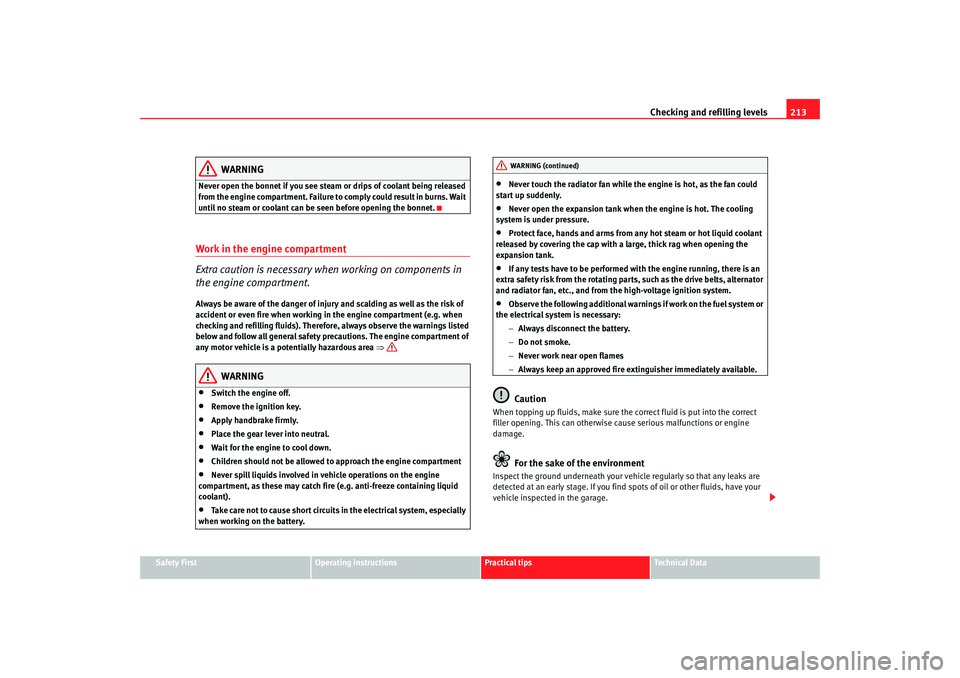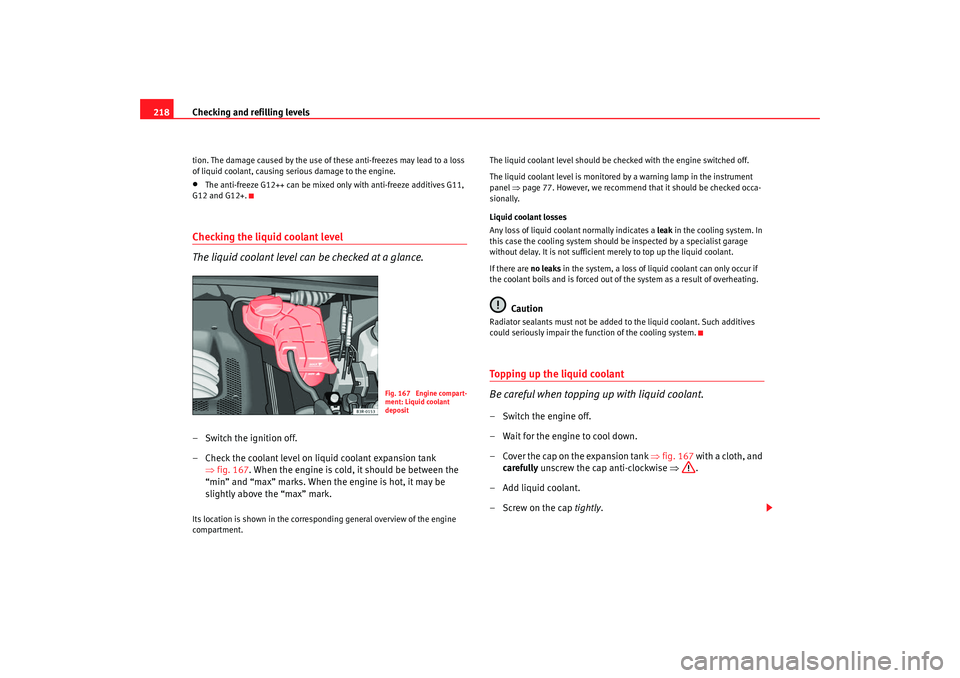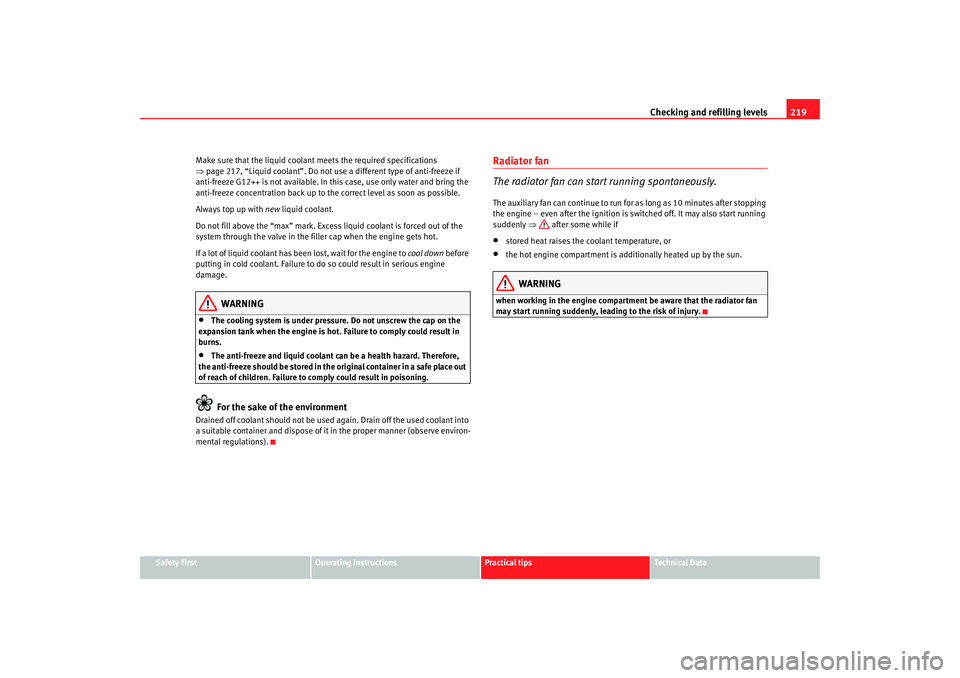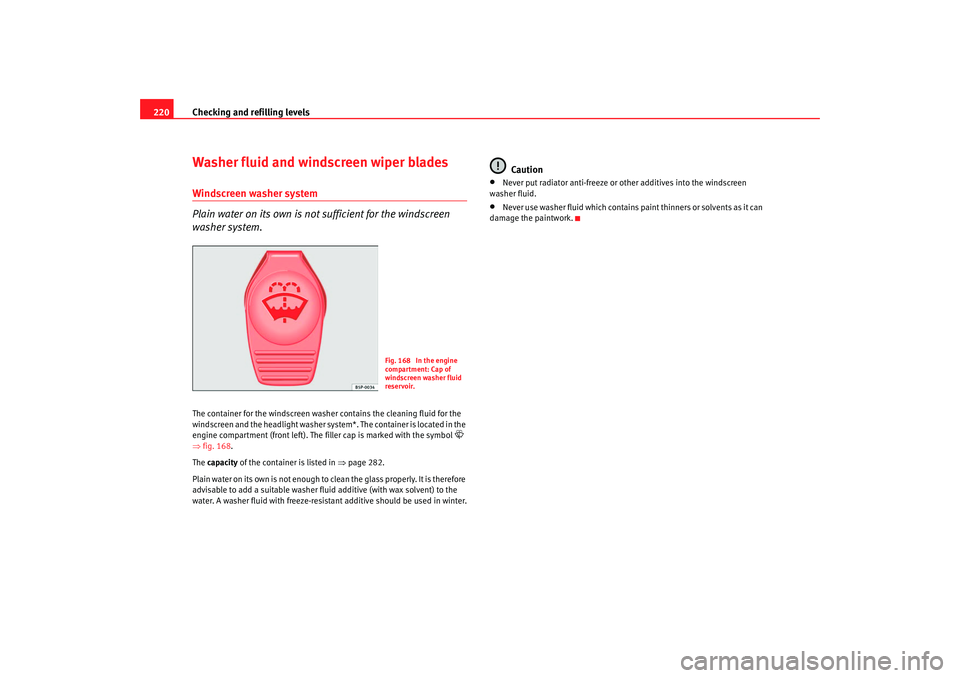radiator cap Seat Exeo 2008 Owner's manual
[x] Cancel search | Manufacturer: SEAT, Model Year: 2008, Model line: Exeo, Model: Seat Exeo 2008Pages: 303, PDF Size: 10.02 MB
Page 215 of 303

Checking and refilling levels213
Safety First
Operating instructions
Practical tips
Te c h n i c a l D a t a
WARNING
Never open the bonnet if you see steam or drips of coolant being released
from the engine compartment. Failure to comply could result in burns. Wait
until no steam or coolant can be seen before opening the bonnet.Work in the engine compartment
Extra caution is necessary when working on components in
the engine compartment.Always be aware of the danger of injury and scalding as well as the risk of
accident or even fire when working in the engine compartment (e.g. when
checking and refilling fluids). Therefor e, always observe the warnings listed
below and follow all general safety precautions. The engine compartment of
any motor vehicle is a potentially hazardous area ⇒
WARNING
•
Switch the engine off.
•
Remove the ignition key.
•
Apply handbrake firmly.
•
Place the gear lever into neutral.
•
Wait for the engine to cool down.
•
Children should not be allowed to approach the engine compartment
•
Never spill liquids involved in vehicle operations on the engine
compartment, as these may catch fire (e.g. anti-freeze containing liquid
coolant).
•
Take care not to cause short circuits in the electrical system, especially
when working on the battery.
•
Never touch the radiator fan while the engine is hot, as the fan could
start up suddenly.
•
Never open the expansion tank when the engine is hot. The cooling
system is under pressure.
•
Protect face, hands and arms from any hot steam or hot liquid coolant
released by covering the cap with a large, thick rag when opening the
expansion tank.
•
If any tests have to be performed with the engine running, there is an
extra safety risk from the rotating parts, such as the drive belts, alternator
and radiator fan, etc., and from the high-voltage ignition system.
•
Observe the following additional warnings if work on the fuel system or
the electrical system is necessary:
−Always disconnect the battery.
− Do not smoke.
− Never work near open flames
− Always keep an approved fire extinguisher immediately available.Caution
When topping up fluids, make sure the correct fluid is put into the correct
filler opening. This can otherwise cau se serious malfunctions or engine
damage.
For the sake of the environment
Inspect the ground underneath your vehicle regularly so that any leaks are
detected at an early stage. If you find spots of oil or other fluids, have your
vehicle inspected in the garage.
WARNING (continued)
Exeo_EN.book Seite 213 Freitag, 17. Oktober 2008 11:24 11
Page 220 of 303

Checking and refilling levels
218tion. The damage caused by the use of these anti-freezes may lead to a loss
of liquid coolant, causing serious damage to the engine.•
The anti-freeze G12++ can be mixed on ly with anti-freeze additives G11,
G12 and G12+.
Checking the liquid coolant level
The liquid coolant level can be checked at a glance.– Switch the ignition off.
– Check the coolant level on liquid coolant expansion tank ⇒fig. 167. When the engine is cold, it should be between the
“min” and “max” marks. When the engine is hot, it may be
slightly above the “max” mark.Its location is shown in the correspon ding general overview of the engine
compartment. The liquid coolant level should be checked with the engine switched off.
The liquid coolant level is monitored
by a warning lamp in the instrument
panel ⇒ page 77. However, we recommend that it should be checked occa-
sionally.
Liquid coolant losses
Any loss of liquid coolant normally indicates a leak in the cooling system. In
this case the cooling system should be inspected by a specialist garage
without delay. It is not sufficient merely to top up the liquid coolant.
If there are no leaks in the system, a loss of liquid coolant can only occur if
the coolant boils and is forced out of the system as a result of overheating.
Caution
Radiator sealants must not be added to the liquid coolant. Such additives
could seriously impair the function of the cooling system.Topping up the liquid coolant
Be careful when topping up with liquid coolant.– Switch the engine off.
– Wait for the engine to cool down.
– Cover the cap on the expansion tank ⇒fig. 167 with a cloth, an d
carefully unscrew the cap anti-clockwise ⇒ .
– Add liquid coolant.
– Screw on the cap tightly.
Fig. 167 Engine compart-
ment: Liquid coolant
deposit
Exeo_EN.book Seite 218 Freitag, 17. Oktober 2008 11:24 11
Page 221 of 303

Checking and refilling levels219
Safety First
Operating instructions
Practical tips
Te c h n i c a l D a t a
Make sure that the liquid coolant meets the required specifications
⇒
page 217, “Liquid coolant”. Do not use a different type of anti-freeze if
anti-freeze G12++ is not available. In th is case, use only water and bring the
anti-freeze concentration back up to the correct level as soon as possible.
Always top up with new liquid coolant.
Do not fill above the “max” mark. Excess liquid coolant is forced out of the
system through the valve in the filler cap when the engine gets hot.
If a lot of liquid coolant has been lost, wait for the engine to cool down before
putting in cold coolant. Failure to do so could result in serious engine
damage.
WARNING
•
The cooling system is under pressu re. Do not unscrew the cap on the
expansion tank when the engine is hot. Failure to comply could result in
burns.
•
The anti-freeze and liquid coolant c an be a health hazard. Therefore,
the anti-freeze should be stored in the original container in a safe place out
of reach of children. Failure to comply could result in poisoning.For the sake of the environment
Drained off coolant should not be used again. Drain off the used coolant into
a suitable container and dispose of it in the proper manner (observe environ-
mental regulations).
Radiator fan
The radiator fan can start running spontaneously.The auxiliary fan can continue to run for as long as 10 minutes after stopping
the engine – even after the ignition is switched off. It may also start running
suddenly ⇒ after some while if•
stored heat raises the coolant temperature, or
•
the hot engine compartment is additionally heated up by the sun.
WARNING
when working in the engine compartment be aware that the radiator fan
may start running suddenly, leading to the risk of injury.
Exeo_EN.book Seite 219 Freitag, 17. Oktober 2008 11:24 11
Page 222 of 303

Checking and refilling levels
220Washer fluid and windscreen wiper bladesWindscreen washer system
Plain water on its own is not sufficient for the windscreen
washer system.The container for the windscreen washer contains the cleaning fluid for the
windscreen and the headlight washer system*. The container is located in the
engine compartment (front left). Th e filler cap is marked with the symbol
⇒ fig. 168 .
The capacity of the container is listed in ⇒page 282.
Plain water on its own is not enough to clean the glass properly. It is therefore
advisable to add a suitable washer fluid additive (with wax solvent) to the
water. A washer fluid with freeze-resistant additive should be used in winter.
Caution
•
Never put radiator anti-freeze or other additives into the windscreen
washer fluid.
•
Never use washer fluid which contains paint thinners or solvents as it can
damage the paintwork.
Fig. 168 In the engine
compartment: Cap of
windscreen washer fluid
reservoir.
Exeo_EN.book Seite 220 Freitag, 17. Oktober 2008 11:24 11